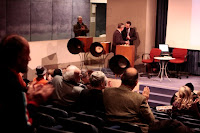
09 febbraio, 2010
03 febbraio, 2010
The futurism noises machines

02 febbraio, 2010
1910: Futurism in Trieste
Estratto dalla brocure: "12 gennaio 1910: una data storica per il Futurismo. Al Politeama Rossetti di Trieste si tenne quel giorno la prima in assoluto delle “serate futuriste” con cui Filippo Tommaso Marinetti intendeva “lanciare” clamorosamente il proprio movimento, a quasi un anno dalla diffusione sulla stampa italiana e francese del Manifesto fondativo.
Fu una serata tumultuosa, con il pubblico vivacemente diviso tra sostenitori e detrattori delle “novità” proposte da Marinetti e da due suoi adepti, i poeti Aldo Mazza e Aldo Palazzeschi: “novità” che, in una Trieste ancora irredenta, avevano anche il sapore di una palese provocazione politica e propugnavano, tra l’altro, “la guerra, sola igiene del mondo”. Non a torto, dunque, Trieste – dove già Marinetti aveva suscitato scalpore in precedenti occasioni pubbliche – venne da allora definita una delle tre capitali del Futurismo, assieme a Parigi e a Milano."
Tratto da Wikipedia: "Il Futurismo nasce in un periodo (inizio Novecento) di grande fase evolutiva dove tutto il mondo dell'arte e della cultura era stimolato da moltissimi fattori determinanti: le guerre, la trasformazione sociale dei popoli, i grandi cambiamenti politici, e le nuove scoperte tecnologiche e dicomunicazione come il telegrafo senza fili, la radio, aeroplani e le prime cineprese; tutti fattori che arrivarono a cambiare completamente la percezione delle distanze e del tempo, "avvicinando" fra loro i continenti. Il XX secolo era quindi invaso da un nuovo vento, che portava all'interno dell'essere umano una nuova realtà: la velocità. Le catene di montaggio abbattevano i tempi di produzione, le automobili aumentavano ogni giorno, le strade iniziarono a riempirsi di luce artificiale, si avvertiva questa nuova sensazione di futuro e velocità sia nel tempo impiegato per produrre o arrivare ad una destinazione, sia nei nuovi spazi che potevano essere percorsi, sia nelle nuove possibilità di comunicazione." (leggi QUI)




















